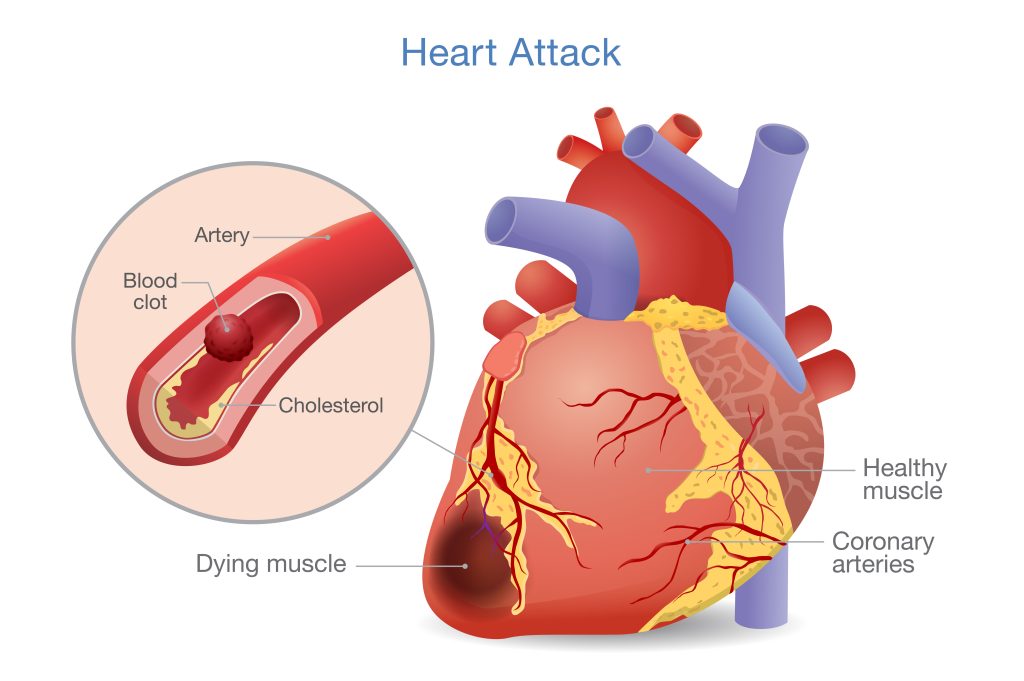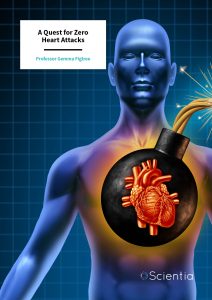Professor Gemma Figtree | A Quest for Zero Heart Attacks
Heart attacks and cardiovascular disease are broadly considered to be the result of unhealthy habits and underlying health issues. However, pioneering research led by interventional cardiologist Professor Gemma Figtree from the University of Sydney reveals that approximately one-quarter of first-time heart attack patients do not have any known modifiable risk factors. These patients develop ‘silent’ coronary artery disease, without any warning signs. Professor Figtree and her international team at CAD Frontiers are pioneering a new approach to heart attack prevention that goes beyond traditional risk factors and symptoms.
The Leading Cause of Mortality
In the average lifetime, our hearts beat three billion times, nourishing themselves through the coronary arteries. It is widely understood that smoking, high blood pressure, diabetes, and high cholesterol levels can damage these arteries, leading to the formation of fatty deposits. If this obstruction becomes complete – most often involving rupture of the plaque and triggering a blood clot – energy and oxygen supply stop altogether to a section of the heart, causing a heart attack. Unless treated promptly, this can be life-threatening.
In Australia, a country with a population of 27.5 million people, a heart attack occurs every nine minutes. Tragically, some individuals succumb instantly, even before an ambulance can be called. The lives of those who survive are often blighted by long-term consequences.
Physicians worldwide strive to identify individuals at risk of coronary artery narrowing and prevent the condition’s progression before it leads to a heart attack. Traditionally, clinicians have relied on modifiable risk factors such as cholesterol, blood pressure, smoking and diabetes to guide preventive strategies. However, an increasing number of first-time heart attack patients have no risk factor ‘alarms’ and silently develop coronary artery disease (CAD) over time. It is not uncommon for patients to present with extensive atherosclerosis and a life-threatening heart attack without any evident risk factors or prior symptoms, leaving them questioning, ‘Why me?’.
Recent data highlight the importance of unravelling new markers for CAD. In 2015, approximately 27% of patients with identified plaque rupture and life-threatening ST-elevation myocardial infarction (STEMI) had none of the Standard Modifiable cardiovascular Risk Factors (SMuRFs). This proportion has steadily risen from 14% over the past decade.
Professor Gemma Figtree of the University of Sydney and her team have spearheaded a global effort to understand the mechanisms, outcomes, and management of this SMuRFless patient group. Collaborating with the SWEDEHEART registry, which includes 62,048 STEMI patients, in 2021 they reported in The Lancet on the experience of people with SMuRFs compared to those without. Worryingly, these SMuRFless individuals fared poorly after initial hospital treatment. A greater number of them died within 30 days of the initial heart attack compared to patients with traditional risk factors, a trend that disproportionately affected women. In patients predisposed to heart attacks due to smoking, diabetes, high blood pressure or high cholesterol levels, addressing the underlying problem will drastically reduce the chances of first time or recurrent heart attacks. But what can be done to prevent a heart attack in someone who doesn’t present with any of these modifiable factors?

Invisible Heart Attack Patients in Trials and Guidelines
In their study of the medical literature, Professor Figtree and her team discovered a striking omission. Out of 256 clinical trials reporting on heart attack treatment, none of them reported the number of SMuRFless patients included in the study or the outcomes of their treatment.
Various national and international guidelines provide detailed steps for physicians to follow in the preventive management of heart attack patients with modifiable risk factors. However, the researchers found no specific guidance on managing heart attack patients who lack these risk factors. Professor Figtree refers to these SMuRFless patients as ‘invisible’ in current management and research. Consequently, an estimated 1.34 million people worldwide die each year as a result of SMuRFless heart attacks.
A Call for Action
In response to the challenges faced by these invisible patients, Professor Figtree has led an international consortium of physicians, scientists and industry experts under the banner of CAD Frontiers, with key founding partners, the University of Sydney, Snow Medical Research Foundation, LaTrobe University, Baker Heart and Diabetes Institute, and Monash University (CADFrontiers.com.au). While the initiative is Australian-based, the team has an established international presence, with leading experts from Europe, Asia, and America working towards the vision of ‘a world without heart attacks’. The team collaborates with patient groups, healthcare partners and experts in the commercialisation of emerging medical technologies to accelerate the translation of urgently needed solutions.

Confronting a Complex Challenge
The first challenge facing the consortium is understanding why these patients experience heart attacks in the absence of traditional risk factors. While extensive research has explored the mechanisms behind CAD in response to smoking, diabetes, high blood pressure and high cholesterol, medical science has limited insight into why some individuals develop this condition in the absence of recognised risk factors. As this patient group represents a subset of heart attack sufferers, their unique data must be separated from the broader patient population. Professor Figtree emphasises the need to ‘split’ rather than ‘lump together’ this group, suggesting that modern approaches utilising artificial intelligence may hold the key.
Unlocking the Potential of ‘Omics’
The concept of ‘omics’ may be unfamiliar to many non-scientists. In brief, this technology enables the identification of all genetic information (genomics), proteins (proteomics), fats (lipidomics) or produced chemicals (metabolomics) within an individual. Recent technological advancements have made rapid and comprehensive analysis of these biological molecules possible.
If specific ‘omic signatures’ for particular medical conditions can be identified, these signatures can be used to predict disease. SMuRFless CAD – conservatively estimated to cause 1.34 million deaths in 2019 alone – ranks among the top five conditions driving global mortality. Even if a marker could accurately identify 50% of otherwise overlooked patients with silent CAD, it has the potential to dramatically reduce heart attacks.
Professor Figtree and her team continue to make advances in identifying previously unrecognised molecules in the blood that can serve as powerful biomarkers for assessing the burden and activity of silent CAD. The overarching aim of CAD Frontiers is to develop a series of blood-based biomarkers for CAD, revolutionising heart attack prevention. Simultaneously, the team aims to explore the identified CAD biomarkers and whether they point to potential novel therapeutic targets.

Looking Ahead to Future Therapies
Most current drugs used for the clinical management of CAD and heart attack prevention target modifiable risk factors, such as statins for cholesterol and angiotensin-converting enzyme inhibitors for blood pressure. However, our understanding of the factors driving individual susceptibility and resilience to CAD remains limited.
CAD Frontiers’ drug development programme adopts a novel approach, leveraging relevant expertise, resources, and partnerships to advance knowledge regarding causal factors of CAD, identify diagnostic targets, and develop new treatments in a bench-to-bedside approach. This comprehensive translational pathway ensures the discovery and translation of new therapeutic pathways and drugs that benefit all individuals at risk of heart attacks and sudden death.
The development of new drugs faces significant obstacles, particularly the cost of clinical trials, which can amount to billions of dollars. CAD Frontiers believes that costs can be reduced by up to 20-fold through targeted testing on smaller, better-characterised patient populations. Changes in trial design and reporting can also expedite the process of bringing new drugs to market.
Professor Figtree emphasises the global inequality in healthcare provision, with approximately 75% of all heart disease patients residing in low- and middle-income countries. Access to new drugs and treatments may be challenging or impossible for individuals in these regions. CAD Frontiers aims to improve healthcare in disadvantaged communities, including ensuring more equitable access to therapeutics in poorer countries.
Making Heart Attacks a Thing of the Past
CAD Frontiers presents a new vision and strategy to address the leading cause of premature death worldwide. By reframing the question and assembling a team of multidisciplinary experts, the initiative aims to make significant breakthroughs in heart attack prevention. Led by Professor Figtree, the international team possesses the expertise, track record, and determination to succeed. Initial funding is already in place, and negotiations with international research and development programs for additional financing are underway. The success of the COVID-19 vaccine program demonstrated the rapid results achievable through inventive international collaboration among scientists and physicians. Professor Figtree hopes to replicate this success by finding new diagnostic methods and treatment options for heart attack management and prevention. With the goal of benefiting the 18 million people worldwide who die from heart disease each year, we can only hope that they succeed – and succeed soon.
SHARE
DOWNLOAD E-BOOK
REFERENCE
https://doi.org/10.33548/SCIENTIA915
MEET THE RESEARCHER

Professor Gemma Figtree, AM
Medicine, Northern Clinical School
Kolling Institute of Medical Research
University of Sydney
Australia
Gemma Figtree is a professor in medicine and chair of the multi-disciplinary Cardiovascular Initiative at the University of Sydney and an interventional cardiologist at Royal North Shore Hospital, a pioneering centre for the treatment of acute heart attack. She has an international track record across a diverse range of fundamental, translational and implementation research areas, and is recognised for her strategic leadership.
Professor Figtree is committed to preventing heart attacks through innovations to detect and treat silent coronary artery disease (CAD). She leads a diverse team unravelling key mechanisms underlying susceptibility and response to heart attack, with studies extending from the bench to large cohort studies and clinical trials. Discoveries in her laboratory have been published in leading journals including the Lancet, Circulation, Journal of the American College of Cardiology and European Heart Journal, with more than 220 publications. Professor Figtree is an investigator on grants totalling more than $42 million. She has an awarded patent and five provisional patents and is the chief medical officer for Prokardia. She is the Chief Scientific Officer of CAD Frontiers, a non-profit venture facilitating collaborations between global clinical, research, policy and industry leaders as an effective platform combining discovery science, clinical trials and commercial translation, with a vision of a world without heart attacks.
Professor Figtree was awarded a National Health and Medical Research Council Excellence Award for Top Ranked Practitioner Fellow (Australia, 2018), NSW Ministerial Award for Cardiovascular Research Excellence (2019) and awarded Member of the Order of Australia (2023). She serves as a member of the Editorial Board of leading international journals including Circulation and Cardiovascular Research and an associate editor for Heart, Lung and Circulation.
Professor Figtree’s advocacy work and strategic leadership as president of the Australian Cardiovascular Alliance helped secure Federal commitment to the $220 million Medical Research Future Fund Mission for Cardiovascular Health, which she now chairs. The Mission provides an historic opportunity for a broad range of Australian cardiovascular researchers to work closely with policy makers and healthcare practitioners to tackle major clinical hurdles with translational impact. She is intimately involved in guiding the introduction of diagnostic strategies and management algorithms into clinical practice through her role as chair of the Heart Foundation Heart Health Committee, as well as via regular consultation to the NSW Office for Health & Medical Research and NSW Health (e.g., on the Expert Advisory Group for Premature Cardiovascular Death). She is a co-author of the recent Lancet Commission for Women and Cardiovascular Disease (with initial publication in The Lancet in April 2021). She is a graduate of the Australian Institute of Company Directors and serves as a non-executive Director on multiple community Boards.
CONTACT
E: gemma.figtree@sydney.edu.au
W: https://www.sydney.edu.au/medicine-health/about/our-people/academic-staff/gemma-figtree.html
T: @gemtreee
FURTHER READING
GA Figtree, K Broadfoot, B Casadei, et al., A call to action for new global approaches to cardiovascular disease drug solutions, European Heart Journal, 2021, 42(15), 1464–1475. DOI: https://doi.org/10.1093/eurheartj/ehab068
GA Figtree, ST Vernon, N Hadziosmanovic, et al., Mortality in STEMI patients without standard modifiable risk factors: a sex-disaggregated analysis of SWEDEHEART registry data, Lancet, 2021, 397(10279), 1085–1094. DOI: https://doi.org/10.1016/S0140-6736(21)00272-5
ST Vernon, S Coffey, R Bhindi, et al., Increasing proportion of ST elevation myocardial infarction patients with coronary atherosclerosis poorly explained by standard modifiable risk factors, European Journal of Preventive Cardiology, 2017, 24(17), 1824–1830. DOI: https://doi.org/10.1177/2047487317720287
FUNDING
Medical Research Future Fund (Federal)
National Health and Medical Research Council (Federal)
NSW Office of Health and Medical Research

REPUBLISH OUR ARTICLES
We encourage all formats of sharing and republishing of our articles. Whether you want to host on your website, publication or blog, we welcome this. Find out more
Creative Commons Licence (CC BY 4.0)
This work is licensed under a Creative Commons Attribution 4.0 International License. 
What does this mean?
Share: You can copy and redistribute the material in any medium or format
Adapt: You can change, and build upon the material for any purpose, even commercially.
Credit: You must give appropriate credit, provide a link to the license, and indicate if changes were made.
SUBSCRIBE NOW
Follow Us
MORE ARTICLES YOU MAY LIKE
Dr Ralf Adam | New Technologies Shaping the Future of Oral Hygiene
Understanding the efficiency of various toothbrush technologies is essential for achieving optimal oral health. Dr Ralf Adam, who leads a dedicated team at Procter & Gamble in Germany, is keen to investigate the complexities of these technologies. His team have provided new insights into the best toothbrush types for plaque removal and the maintenance of gum health. By highlighting the importance of informed oral care decisions and ongoing investigations, this vital research works towards ensuring everyone can achieve a brighter, healthier smile.
Dr Toby Phesse | Revealing the Mysteries of Wnt Signalling: Novel Approaches to Beating Cancer
Cancer remains a leading cause of mortality worldwide, and the need for new, more effective treatments remains an urgent challenge. Dr Toby Phesse from Cardiff University in the UK focuses on the role of the Wnt receptor found on the surface of cells and its involvement with cell communication and cancer growth, bringing fresh hopes for new therapeutic options.
Dr Vijay Reddy | The Virus World Database: An Invaluable Resource for Public Health and Healthcare
Severe viral disease presents an ongoing challenge to the health of humankind. While unparalleled developments in science and technology are improving our understanding of such viruses, this information needs to be readily accessible to researchers to ensure continued progress in public health and healthcare. Dr Vijay Reddy and his colleagues at the Hormel Institute (University of Minnesota) developed the Virus World database, an invaluable resource that details the genome, structure, and host of practically every discovered virus to date.
Professor Ralf Herwig | Deciphering the Enigma of Vitamin D and the Immune System
Vitamin D has been studied as a treatment for a large number of diseases and conditions, from cancer to autism to COVID-19. However, its mode of action is not completely understood. Professor Ralf Herwig carries out his research at HG Pharma GmbH (Austria) and Ulster University (UK). His vital work explores the role of vitamin D in the body with a view to unlocking its potential as a treatment for a variety of health conditions involving the immune system.





